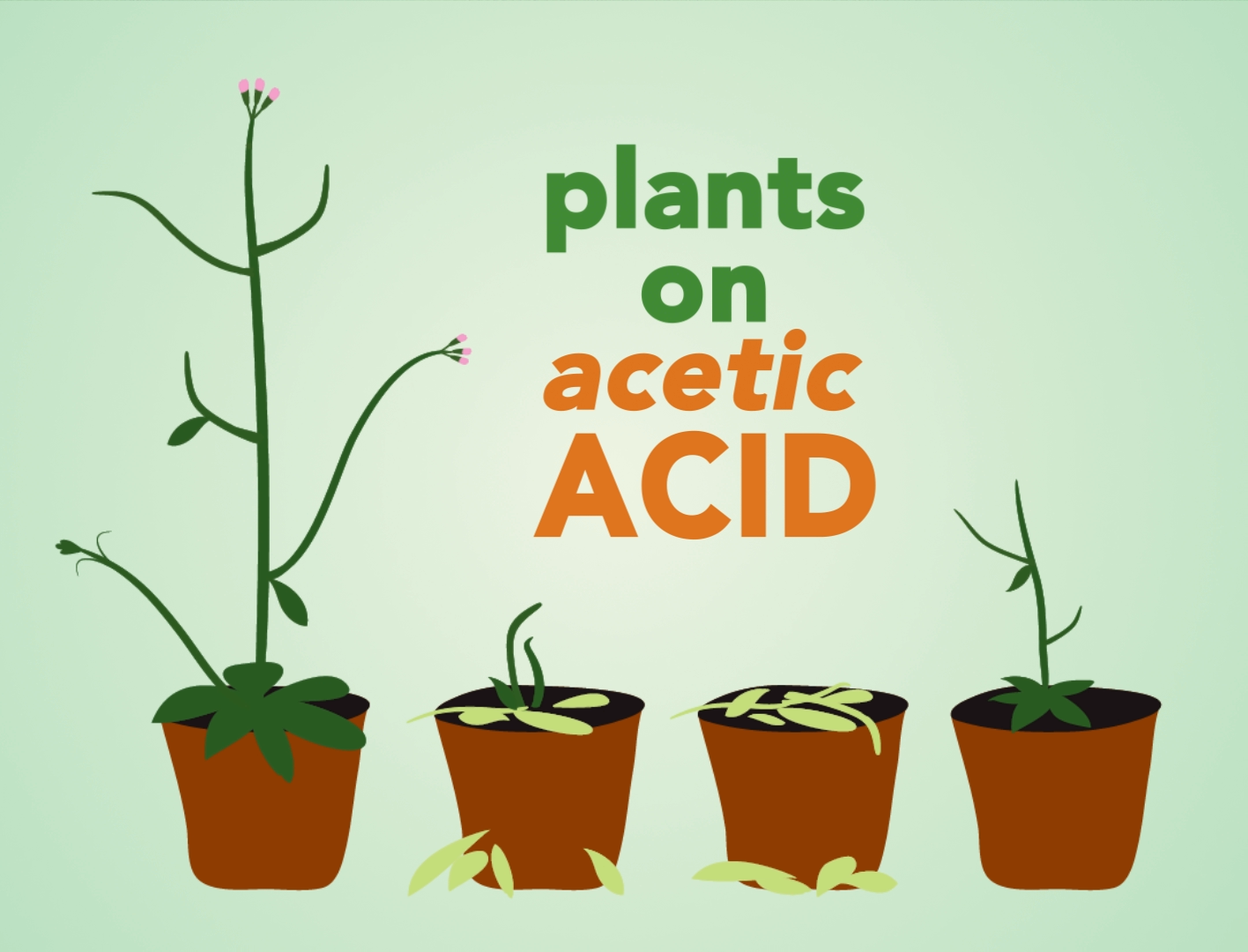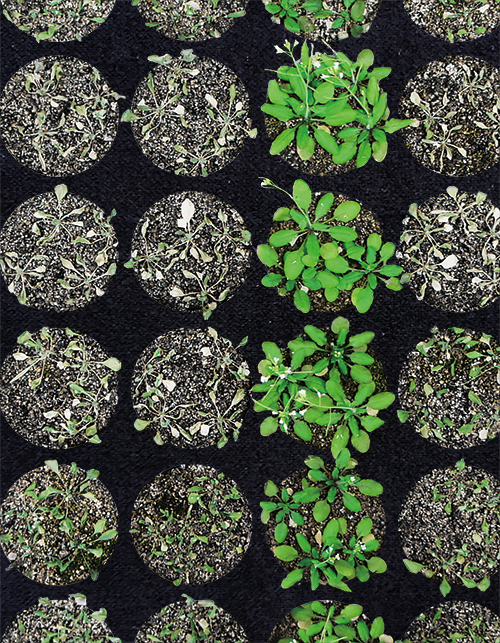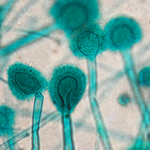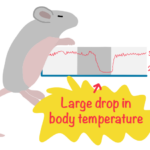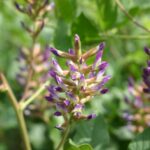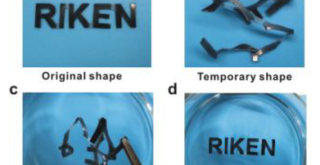What they knew
The first discovery came about after analyzing a mutant Arabidopsis plant (the HDA6 mutant) that is more tolerant to drought than normal Arabidopsis plants. They found that these plants produced more acetic acid than wild-type plants. They also found that plants with mutations that reduced acetic acid production became even less tolerant to drought than wild-type plants.
The fantastic part of the study was realizing that whatever the acetic acid was doing to help resist drought, it didn’t matter how it got into the plants. So, even non-mutant plants became more drought resistant when acetic acid was added to the soil they were growing in. But this solution might not always be practical, and growing plants in acetic acid-treated soil for extended periods of time might negatively affect plant growth.
The other way to get acetic acid into plants is to have them make more of it themselves. But, unless this process can be regulated, excess production of acetic acid might hinder plant growth and development (this is basically the same outcome as growing plants in acetic acid-treated soil for extended periods of time).
What they did
The new study addressed this issue by creating a transgenic plant that increases acetic acid production only when water is scarce. As a co-author Khurram Bashir explains, “we wanted to fine tune acetic acid biosynthesis in Arabidopsis to develop plants with the ability to survive during times of drought, but with minimum disturbances in plant structure or function.”
In order to make a transgene that allowed drought stress to drive the synthesis of acetic acid, the team needed two things.
First, they needed genes that increase acetic acid production when expressed in plants. This was not too difficult because earlier studies have already shown that two genes from the acetic acid biosynthesis pathway (PDC1 and ALDH2B7) are expressed more (upregulated) in plants when they experience drought stress, and both of these genes are needed by plants to convert glucose into acetic acid.
Then, they needed a gene to link PDC1 and ALDH2B7 expression to water deprivation. This was the major challenge for the study. The team performed microarray analysis to find a gene that satisfied the following criteria:
- Not expressed under normal conditions
- Quickly upregulated in roots and shoots when access to water is very limited.
Initial analysis suggested that theTSPO gene was a good candidate. Testing showed that TSPO expression in plants was almost zero under normal conditions, but increased in both roots and shoots by the third day of water deprivation.
With these positive results, they created two transgenic plants (pTSPO-PDC1 and pTSPO-ALDH2B7) by attaching theTSPO promoter to the PDC1 or ALDH2B7 gene and inserting the transgene into Arabidopsis plants.
The drought-stress test
Two weeks after germinating (growing from seeds), plants were deprived of water for around 2 weeks to mimic drought conditions. After water deprivation, they were watered for 2 days and then examined.
The results
As expected, after seven days of drought stress, ALDH2B7 expression increased in the roots and shoots of the pTSPO-ALDH2B7 transgenic plants, as did PDC1 in the pTSPO-PDC1 transgenic plants.

Survival of pTSPO-PDC1 transgenic plants in times of drought stress. Wildtype (left column) and transgenic plants (other columns; Two plants each from four pTSPO-PDC1 lines) were re-watered after 15 days without water. Significantly more transgenic plants survived.
Of course, the goal was to make sure that this helped plants survive. After re-watering plants at the end of the drought-stress test, the team found that both transgenic lines had higher survival rates than the unmodified plants, with the pTSPO-ALDH2B7 line outperforming the pTSPO-PDC1 line.
The impact
Transgenic plants are one way to address agricultural problems stemming from water shortages. The advantage of the method described here is that growing conditions are normal and plants are unchanged, except that they internally produce much more acetic acid than unmodified plants when water becomes scarce. The same technique could be extended to agricultural crops.
“As acetic acid treatment was shown to be effective in crops such as rice, wheat, and maize, the same should be true for transgenic crops made using the transgene that we developed here”, says Bashir. “Therefore, this novel approach to improve drought tolerance could provide a practical solution to agricultural problems in the future.” ✅
What they knew
The first discovery came about after analyzing a mutant Arabidopsis plant (the HDA6 mutant) that is more tolerant to drought than normal Arabidopsis plants. They found that these plants produced more acetic acid than wild-type plants. They also found that plants with mutations that reduced acetic acid production became even less tolerant to drought than wild-type plants.
The fantastic part of the study was realizing that whatever the acetic acid was doing to help resist drought, it didn’t matter how it got into the plants. So, even non-mutant plants became more drought resistant when acetic acid was added to the soil they were growing in. But this solution might not always be practical, and growing plants in acetic acid-treated soil for extended periods of time might negatively affect plant growth.
The other way to get acetic acid into plants is to have them make more of it themselves. But, unless this process can be regulated, excess production of acetic acid might hinder plant growth and development (this is basically the same outcome as growing plants in acetic acid-treated soil for extended periods of time).
What they did
The new study addressed this issue by creating a transgenic plant that increases acetic acid production only when water is scarce. As a co-author Khurram Bashir explains, “we wanted to fine tune acetic acid biosynthesis in Arabidopsis to develop plants with the ability to survive during times of drought, but with minimum disturbances in plant structure or function.”
In order to make a transgene that allowed drought stress to drive the synthesis of acetic acid, the team needed two things.
First, they needed genes that increase acetic acid production when expressed in plants. This was not too difficult because earlier studies have already shown that two genes from the acetic acid biosynthesis pathway (PDC1 and ALDH2B7) are expressed more (upregulated) in plants when they experience drought stress, and both of these genes are needed by plants to convert glucose into acetic acid.
Then, they needed a gene to link PDC1 and ALDH2B7 expression to water deprivation. This was the major challenge for the study. The team performed microarray analysis to find a gene that satisfied the following criteria:
- Not expressed under normal conditions
- Quickly upregulated in roots and shoots when access to water is very limited.
Initial analysis suggested that theTSPO gene was a good candidate. Testing showed that TSPO expression in plants was almost zero under normal conditions, but increased in both roots and shoots by the third day of water deprivation.
With these positive results, they created two transgenic plants (pTSPO-PDC1 and pTSPO-ALDH2B7) by attaching theTSPO promoter to the PDC1 or ALDH2B7 gene and inserting the transgene into Arabidopsis plants.
The drought-stress test
Two weeks after germinating (growing from seeds), plants were deprived of water for around 2 weeks to mimic drought conditions. After water deprivation, they were watered for 2 days and then examined.
The results
As expected, after seven days of drought stress, ALDH2B7 expression increased in the roots and shoots of the pTSPO-ALDH2B7 transgenic plants, as did PDC1 in the pTSPO-PDC1 transgenic plants.

Survival of pTSPO-PDC1 transgenic plants in times of drought stress. Wildtype (left column) and transgenic plants (other columns; Two plants each from four pTSPO-PDC1 lines) were re-watered after 15 days without water. Significantly more transgenic plants survived.
Of course, the goal was to make sure that this helped plants survive. After re-watering plants at the end of the drought-stress test, the team found that both transgenic lines had higher survival rates than the unmodified plants, with the pTSPO-ALDH2B7 line outperforming the pTSPO-PDC1 line.
The impact
Transgenic plants are one way to address agricultural problems stemming from water shortages. The advantage of the method described here is that growing conditions are normal and plants are unchanged, except that they internally produce much more acetic acid than unmodified plants when water becomes scarce. The same technique could be extended to agricultural crops.
“As acetic acid treatment was shown to be effective in crops such as rice, wheat, and maize, the same should be true for transgenic crops made using the transgene that we developed here”, says Bashir. “Therefore, this novel approach to improve drought tolerance could provide a practical solution to agricultural problems in the future.” ✅
Rasheed S, Bashir K, Kim JM, Ando M, Tanaka M, Seki M (2018) The modulation of acetic acid pathway genes in Arabidopsis improves survival under drought stress. Scientific Reports, 1(8). doi: 10.1038/s41598-018-26103-2.

